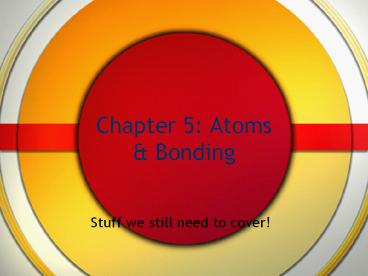Chapter 5: Atoms - PowerPoint PPT Presentation
1 / 7
Title:
Chapter 5: Atoms
Description:
Chapter 5: Atoms & Bonding Stuff we still need to cover! Ionic Bonds (5-2) Polyatomic ions - ions that are made of more than one atom. poly means many. – PowerPoint PPT presentation
Number of Views:33
Avg rating:3.0/5.0
Title: Chapter 5: Atoms
1
Chapter 5 Atoms Bonding
- Stuff we still need to cover!
2
Ionic Bonds (5-2)
- Polyatomic ions - ions that are made of more than
one atom. poly means many. The group of atoms
act as a unit. Ex. Bicarbonate HCO3- (a
component of baking soda) - Subscript - Tells you the ratio of elements that
comprise the compound. In the above polyatomic
ion there is 1 H to 1 C to 3
Oxygen atoms.
3
Naming ionic compounds
- In ionic compounds, the name of the positive ion
comes first, then the negative ion. (metal then
non-metal) - If the negative ion is a single element the name
changes to ide ex. MgO is Magnesium Oxide (not
Oxygen) - If the negative ion is polyatomic the name
usually ends in -ate or -ite - Ex. Ca(NO3)2 calcium nitrate
4
Covalent Bonds 5-3
- Polar bonds - A covalent bond in which electrons
are shared unequally. This causes one side of
the molecule to have a positive charge and the
other to have a negative charge. Water is an
example. - Nonpolar bonds - A covalent bond in which the
electrons are shared equally. There is no
resulting charge on the molecule. Carbon
dioxide is an example.
5
Covalent Bonds
- The number of covalent bonds that a non-metal
atom can form is equal to the number of electrons
it needs to get to 8. - A double bond forms when atoms share two pairs of
electrons. - A triple bond forms when atoms share three pairs
of electrons. (see overhead)
6
Bonding in Metals 5-4
- An alloy is a mixture of 2 or more elements, at
least one of which is a metal. Ex. Brass is a
mixture of copper and zinc. Fe,C,Ni, and Cr
Stainless Steel - Metal atoms combine in regular patterns with the
positive ions packed together and the electrons
bobbing and weaving around them. (forming a sea
of electrons)
7
Metallic Properties
- The sea of electrons model of metallic bonding
explains metallic properties, such as - Malleability, ductility, luster, high electrical
conductivity, and high thermal (heat) conductivity

